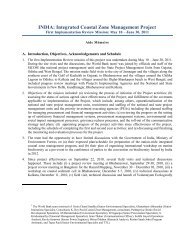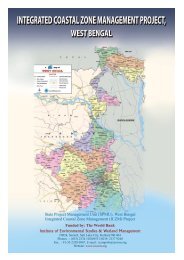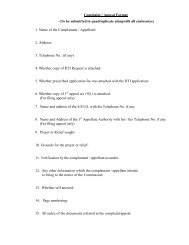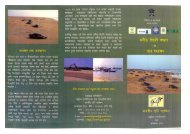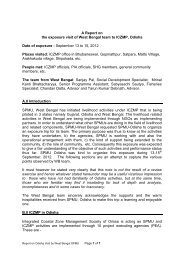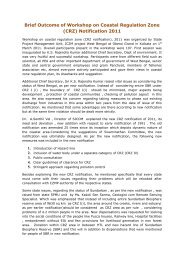Cyclone and Storm Surge - Iczmpwb.org
Cyclone and Storm Surge - Iczmpwb.org
Cyclone and Storm Surge - Iczmpwb.org
Create successful ePaper yourself
Turn your PDF publications into a flip-book with our unique Google optimized e-Paper software.
6.49<br />
shelterbelt (average 100 m width) comprising of Casurina, Subabul <strong>and</strong> other cash crops for this<br />
stretch will be approximately 1.5 crores ( @ Rs. 50,000 per Ha).<br />
6.7. <strong>Cyclone</strong> shelters<br />
Post Disaster damage assessment studies indicate that cyclone <strong>and</strong> consequential flooding claim<br />
many human lives <strong>and</strong> livestock in the coastal district of the state. Most of the housing stock in this<br />
region is made of temporary roof <strong>and</strong> wall material – thus being most vulnerable to the high velocity<br />
winds <strong>and</strong> flooding. Vulnerability of housing stock being the prime reason for loss of human life, there<br />
is a need to provide community cyclone/flood shelters to offset this situation.<br />
Mapping of the vulnerability of human life along with the mapping of cyclone <strong>and</strong> flood hazards helps<br />
in identifying the priority areas for locating cyclone shelters. 12 CD blocks in the South 24 Parganas<br />
enlisted below are in dire need for community cyclone shelters – as the existing hosing stock is more<br />
vulnerable as well as they are located in areas with very high probability of hazard incidence.<br />
Table 6 -1. House type vulnerability in CD blocks identified for community cyclone/flood shelter<br />
C.D Block<br />
Total no. of<br />
Inhabitated<br />
villages<br />
Population<br />
Average<br />
population<br />
per village<br />
% of<br />
Houses<br />
having<br />
temporary<br />
roof<br />
material<br />
% of<br />
Houses<br />
having<br />
temporary<br />
wall<br />
material<br />
Housing<br />
Vulnerability<br />
Index<br />
<strong>Cyclone</strong><br />
Hazard<br />
Level<br />
Proposed<br />
<strong>Cyclone</strong><br />
Shelter<br />
(no.s)<br />
Kultali 43 187989 4372 0.971 0.996 1.997 Very high 172<br />
Basanti 65 278592 4286 0.963 0.991 1.963 Very high 260<br />
Gosaba 50 222822 4456 0.964 0.997 1.977 Very high 200<br />
Mathurapur-II 27 198281 7344 0.937 0.996 1.897 Very high 189<br />
Kakdwip 39 239326 6137 0.907 0.992 1.802 Very high 234<br />
Namkhana 38 160627 4227 0.948 0.995 1.929 Very high 152<br />
Sagar 42 185644 4420 0.964 0.997 1.979 Very high 168<br />
Patharprotima 87 288394 3315 0.967 0.998 1.989 Very high 261<br />
Design consideration for a typical <strong>Cyclone</strong> Shelter<br />
Catcment Area: 2 sq.km approx. or 1000 population, (within 0.75 km travel distance)<br />
[Catchment area for cyclone shelter has been reduced due predominance of creeks <strong>and</strong> channels<br />
one has to cross to reach them]<br />
Design Capacity: 100 - 120 persons (can be augmented upto 200 – 250 persons by<br />
constructing additional floors). This can be used as only cyclone shelter to accommodate<br />
nearly 1000 persons (@5 sgft per person).<br />
Design Area: 5000 sft (@50 sft per person).









